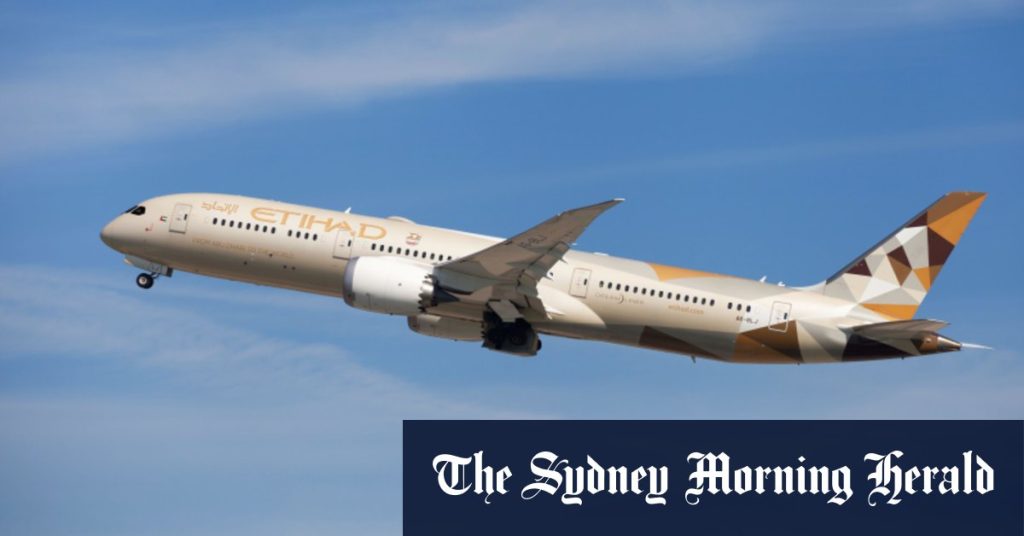On a seemingly ordinary Sunday evening, shortly before 7 pm, Etihad Airways flight EY461, a Boeing 787-9 Dreamliner destined for Abu Dhabi, commenced its takeoff roll on the runway at Melbourne’s Tullamarine Airport. The initial moments unfolded as expected, but as the aircraft gathered speed, an unexpected and dramatic event occurred, forcing the pilots to execute an emergency stop. Reports and video footage captured by onlookers reveal that two of the aircraft’s tires exploded during the takeoff run, prompting the crew to immediately abort the procedure. The sudden deceleration and application of brakes brought the massive aircraft to a halt, averting a potentially catastrophic incident. Emergency response teams, including fire trucks, swiftly arrived at the scene and, as a precautionary measure, doused the Dreamliner’s landing gear with firefighting foam.
Melbourne Airport officials confirmed the incident, stating that the flight had “rejected takeoff.” The airport’s Aviation Rescue and Firefighting Service deployed the firefighting foam as a standard safety protocol in such situations, ensuring that any potential fire hazards were mitigated. Fortunately, there were no reported injuries among the 289 passengers on board. The incident, however, created an immediate logistical challenge. Due to the damage sustained by the aircraft’s tires, it was rendered immobile and unable to be towed off the runway. Airport authorities initiated the process of disembarking the passengers and transporting them back to the terminal via buses. The aircraft remained on the runway for necessary repairs.
The incident underscores the critical importance of robust safety protocols and the rapid response capabilities of airport emergency services. The pilots’ decisive action in aborting the takeoff undoubtedly prevented a potentially far more serious situation. The emergency response teams, including firefighters, played a crucial role in ensuring the safety of the passengers and crew. The deployment of firefighting foam, while a precautionary measure, demonstrated the commitment to minimizing any potential risks associated with the tire explosions. The incident also highlighted the challenges involved in managing such situations, particularly the logistical complexities of disembarking passengers and arranging for their transport back to the terminal while also addressing the disabled aircraft on the runway.
The incident inevitably caused disruption and inconvenience for the passengers, whose travel plans were abruptly interrupted. While the immediate danger was averted, the passengers faced the uncertainty of rescheduled flights and potential delays. The airline, Etihad Airways, faced the task of managing the aftermath of the incident, including arranging alternative travel arrangements for the passengers, conducting a thorough investigation into the cause of the tire explosions, and overseeing the repairs to the aircraft. The incident serves as a reminder of the inherent risks associated with air travel and the importance of stringent safety measures to mitigate those risks.
The investigation into the cause of the tire explosions will be crucial in understanding the factors that contributed to the incident. Possible contributing factors could include runway debris, manufacturing defects in the tires, or improper tire pressure. A thorough investigation will involve examining the damaged tires, assessing the runway conditions, and reviewing maintenance records for the aircraft. The findings of the investigation will be essential in preventing similar incidents in the future and ensuring the continued safety of air travel.
The incident at Melbourne Airport involving Etihad Airways flight EY461 serves as a stark reminder of the potential for unforeseen events in air travel. The rapid response of the pilots and the efficiency of the emergency services played a pivotal role in preventing a potentially catastrophic outcome. The incident also highlighted the importance of comprehensive safety protocols, the need for effective communication between airport authorities and airlines, and the complexities of managing such situations. The subsequent investigation into the cause of the tire explosions will be crucial in identifying any contributing factors and implementing measures to prevent similar incidents from occurring in the future. This incident underscores the ongoing commitment to ensuring the safety and well-being of passengers and crew in the aviation industry.

